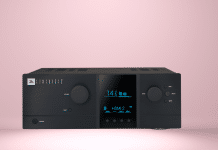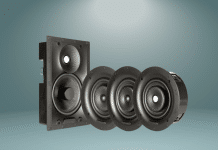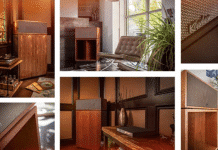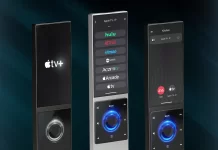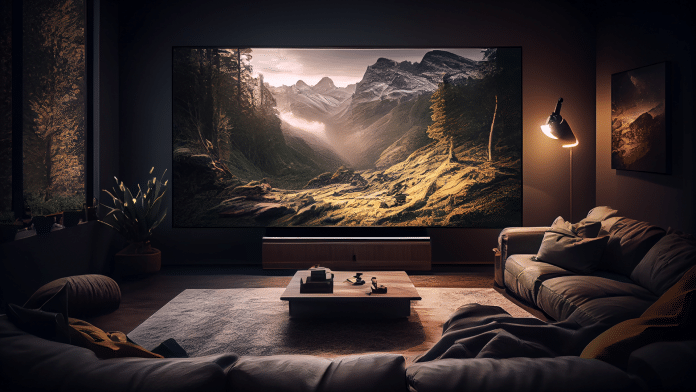
As the boundaries between technology and entertainment continue to blur, the popularity of Home Cinema is transforming the way we view entertainment in our own homes. In the first series, Smart Home World delves into the growing demand and shares professional views on designing Home Cinema.
At Smart Home Expo 2024, a panel discussion spotlighted a notable trend in Home Entertainment: `The Growing Popularity of Home Cinemas.’ This trend extends beyond high-end residences and is now being embraced in affordable luxury homes as well. The discussion highlighted how home cinema systems are becoming increasingly accessible and desirable across various housing segments, driven by advancements in technology and evolving consumer preferences.
Smart Home World explores the trend, examining the growing demand for Home Cinemas and the collaborative efforts between architects, interior designers and brands in crafting cutting-edge entertainment spaces.
Our observation is supported by the research report from Statista, according to Statista’s report, “Revenue in the Home Entertainment market is projected to reach US$0.6bn in 2024. The Home Entertainment market in India has been experiencing significant growth in recent years, driven by changing customer preferences, technological advancements, and favourable macroeconomic factors. HomeOwners in India have been shifting towards home entertainment options, as people are increasingly looking for convenient and immersive entertainment experiences within the comfort of their own homes.”
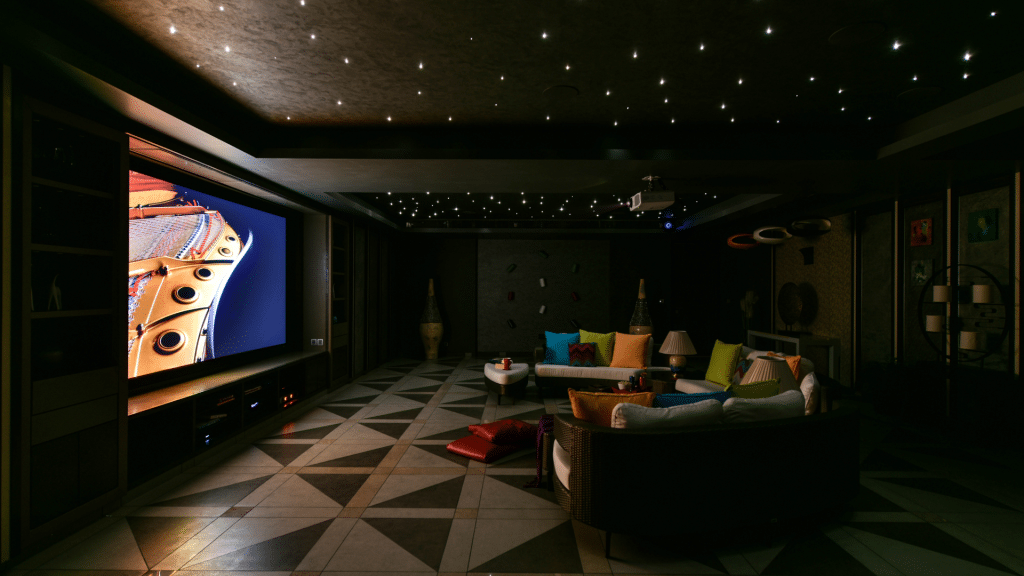
Shift Towards Immersive Audio
Homeowners are increasingly allocating budgets to enhance their home entertainment setups, with a notable focus on audio solutions that provide Immersive sound quality. Systems such as home theatre setups and soundbars are becoming popular choices, delivering High-Fidelity audio that complements high-definition visuals and elevates the cinematic experience. This trend reflects the growing enthusiasm for movies and music, alongside a desire to replicate the theatre experience within the comfort of one’s home.
Plus, the Bollywood and OTT Platforms are significantly shaping consumer preferences for home entertainment. Bollywood’s vibrant storytelling, coupled with its iconic music and dance sequences, has a profound impact on Indian audiences, driving the demand for audio solutions that can deliver a rich and immersive cinematic experience. Similarly, the increasing popularity of OTT platforms has amplified the demand for home entertainment systems capable of providing high-quality audio and visual experiences.
Advancement in Technology has Increased the Demand
One of the major factors that increase the interest in home theatre is technology, this makes it possible for more people to actually add one to their homes. Thanks to ambient light-rejecting screens, short-throw projectors, architecturally friendly Dolby Atmos systems, immersive audio, large LED screens, and motorised window treatments, nearly any room can function admirably as a home theatre.
“There was a time when there were multiple inhibitors — the room is too bright, the space is too small, the speakers won’t fit — to having a home theatre, but not anymore. Several advancements like the adoption of Ultra-High-Definition (UHD) displays, including 4K and 8K screens, have become increasingly prevalent, delivering stunning image clarity and detail that significantly enhances the viewing experience. Alongside this, immersive audio systems featuring advanced technologies like Dolby Atmos and DTS are revolutionising home theatre when it comes to good-quality sound. These systems create a three-dimensional audio environment that makes viewers feel as though they are part of the action.” Says Ar. Shilpa Jain Balvally, Studio Osmosis
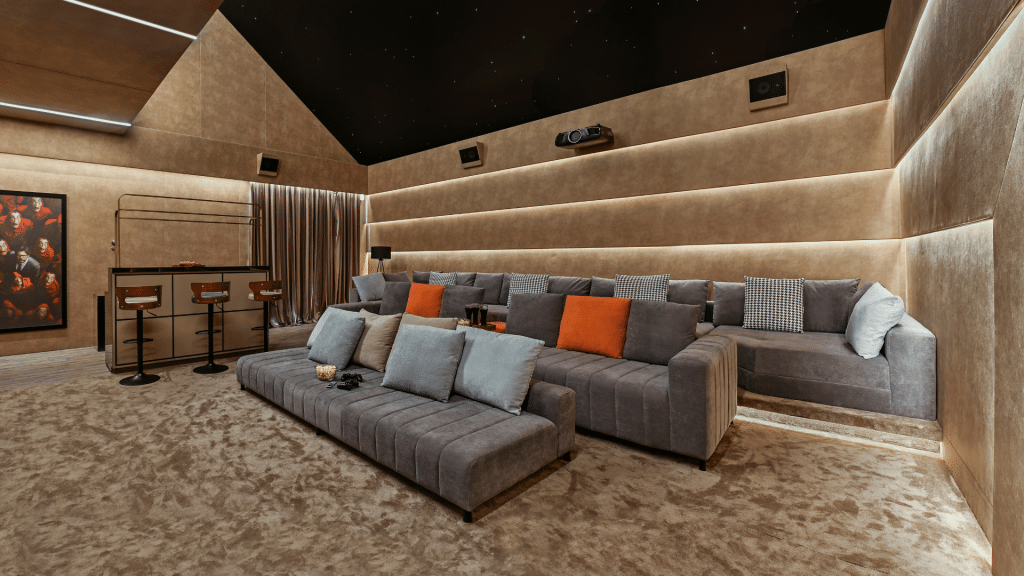
Other added benefits are Modern Home Theatres that also incorporate smart home technology, allowing for seamless control of lighting, audio, and video components through voice commands or mobile apps. This integration offers a more intuitive and user-friendly experience. Customizable seating has become a popular trend, with luxury options such as recliners that include built-in massage functions and personalised configurations designed for maximum comfort and adjustability. Additionally, acoustic treatments are essential for optimising sound quality; the use of acoustic panels, soundproofing materials, and custom-designed layouts helps manage sound and reduce noise interference.
The concept of multifunctional spaces is gaining traction, with home theatres increasingly being integrated into versatile media rooms that can transition between a home theatre and a casual living area, providing greater flexibility.
Smart Home World speaks to prominent professionals who share their insights on the home theatres they have designed for their clients.
Aparna Kaushik, Founder and Architect of Aparna Kaushik Design Group
Home Theatre Design: In our projects, we incorporate several key audio-visual technologies and systems that enhance the viewing and listening experience. This typically includes a large-screen TV or projector with a high-resolution display (such as 4K or even 8K) to ensure sharp and detailed visuals. It often features surround sound systems such as Dolby Atmos or DTS, which use multiple speakers placed strategically around the room (including ceiling speakers) to create a three-dimensional sound experience.
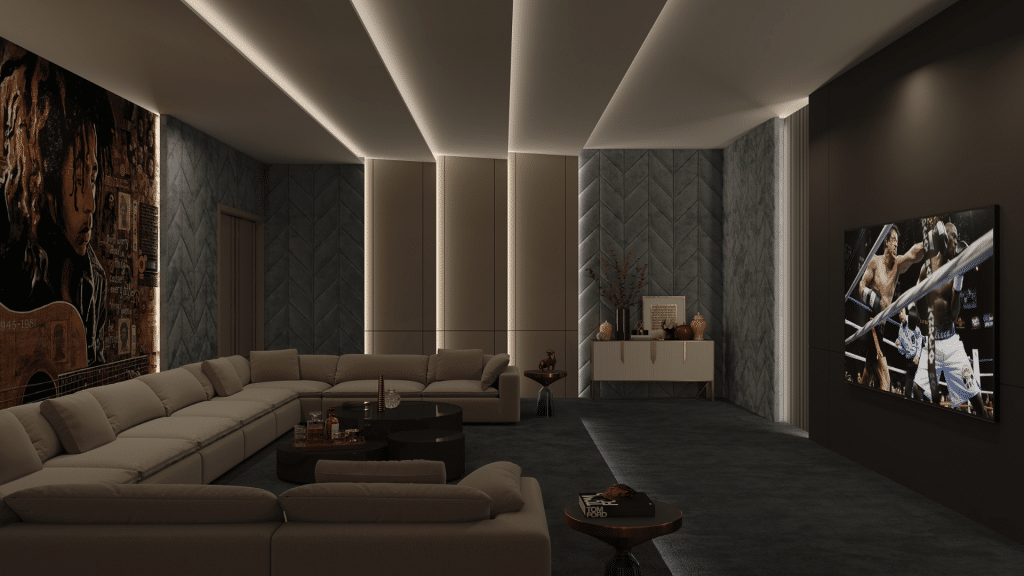
Media Players and Streaming devices allow for easy access to digital content from various sources, including streaming services, Blu-ray players, and media servers. Systems like Google Home or Amazon Alexa can be integrated to control the home theatre environment, adjusting lights, temperature, and even starting up the system with voice commands. Also, Acoustic treatments, Lighting Control Systems, Wireless Connectivity, Remote Control Systems and Motorised Screens can be integrated in home theatre designs. Integrating these technologies requires careful planning and consideration of the room layout, acoustics, and personal preferences to create a customised home theatre experience that meets your needs for both audio and visual quality.
Amit Porwal and Preeti Porwal, Founders of Icon Projects Inspace Pvt Ltd
Home Theatre Design: For this project we have aimed to create an immersive entertainment experience with top-notch audio-visual quality and comfort. It blends personal style with functionality through careful placement of speakers and screens, plush seating for optimal viewing, and smart technology integration for seamless control. Acoustic treatments enhance sound clarity, making every movie night or gaming session a memorable escape into cinematic bliss.
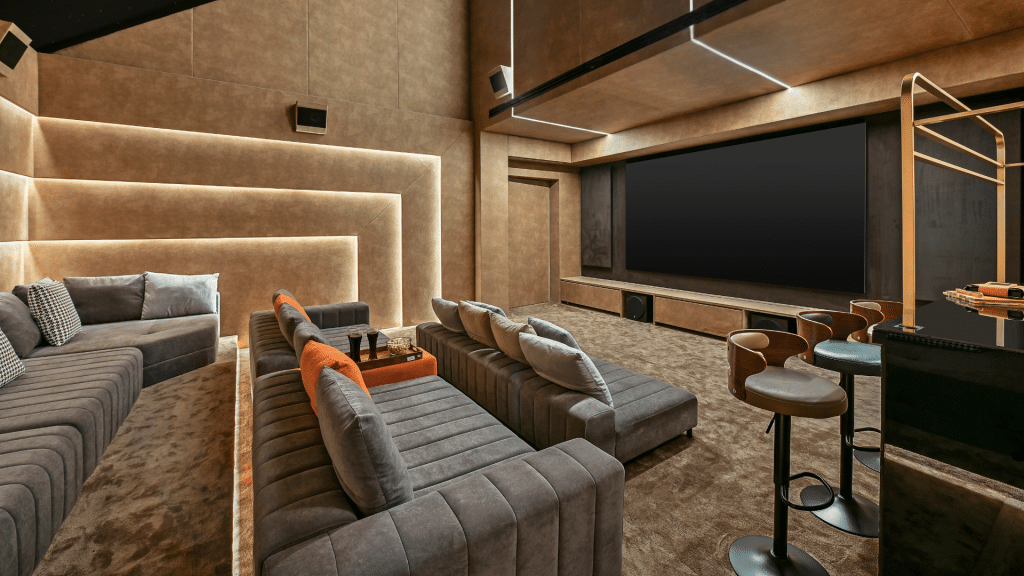
Key audio-visual technologies integrated into home theatre designs include high-definition displays, surround sound systems for various content, smart home integration for centralised control, acoustic treatments for sound clarity, comfortable seating options, and lighting control for ambiance adjustment. These elements combine to create a cinematic experience with optimal audio and visual quality.
Seamless Integration of Technologies
To ensure seamless integration of technologies while maintaining aesthetic and functional integrity, we have employed automation for convenient control that adjusts the ambiance according to the movie.
The home theatre room, sized at 650 sq. ft. post-acoustics, is equipped with a range of high-quality audio and visual components. The setup includes BLUESOUND power amplifiers and Bang & Olufsen speakers for the Front LCR, Surround, and Atmos channels, providing exceptional audio performance. The system is complemented by AMINA subwoofers for deep, resonant bass. For visual clarity, the room features an Epson projector and an Inlight screen. Although cabling and recliners were not specified in this setup, the focus remains on delivering an immersive and high-fidelity entertainment experience.
Maulik Unadkat, Founder, Beyond Alliance
Home Theatre Design
As a Home Theatre designer, our goal is to reproduce the artistic intent of the content as it is. In simple language, every producer creates or records the audio and video in a certain manner in which they want the listener to experience it. The home theatre must deliver this without any manipulation or compromise. This is the main design objective.
Dolby sets standards in the industry in terms of what are the permissible angles and heights at which speakers need to be placed to experience the ideal Atmos effect as intended by the recording studio. Each of these standards is aimed to be met by us in our design is what we focus on.
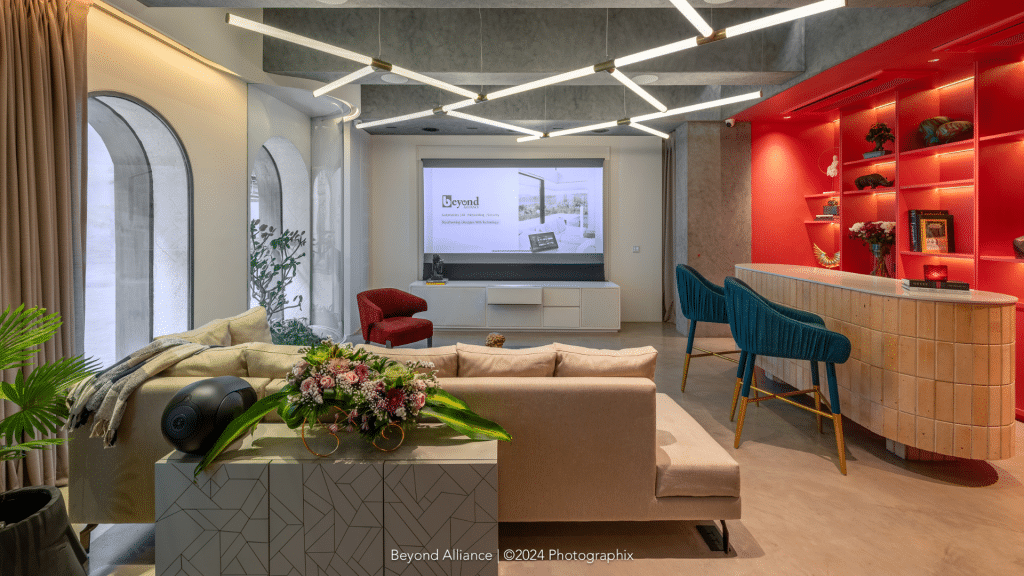
The next most important thing is calibration. THX and HAA certifications have helped us understand calibration in depth. The prime listening area must be calibrated such that all speakers are configured to deliver the best immersive experience.
Audio-Visual Technologies Integrated
4K laser projectors with an acoustic fabric screen bring the visuals alive. Krix, one of the best brands in home theatre, is used in this space. 3 large LCR speakers concealed behind the screen with 2 subwoofers to create an impactful soundstage. The Atmos and surround speakers are calculatedly placed to envelope sound to make the listener intrigued in the experience. All these are driven by extremely clean power and an Atmos processor to bring out the magical experience.
A Basalte server sitting at the back end to seamlessly integrate controls of the lights, AC and AV into a sleek Basalte remote and aesthetic keypads on the wall. The cherry on the cake is HomeKit sitting above these to add Siri voice controls of the Home Theatre.
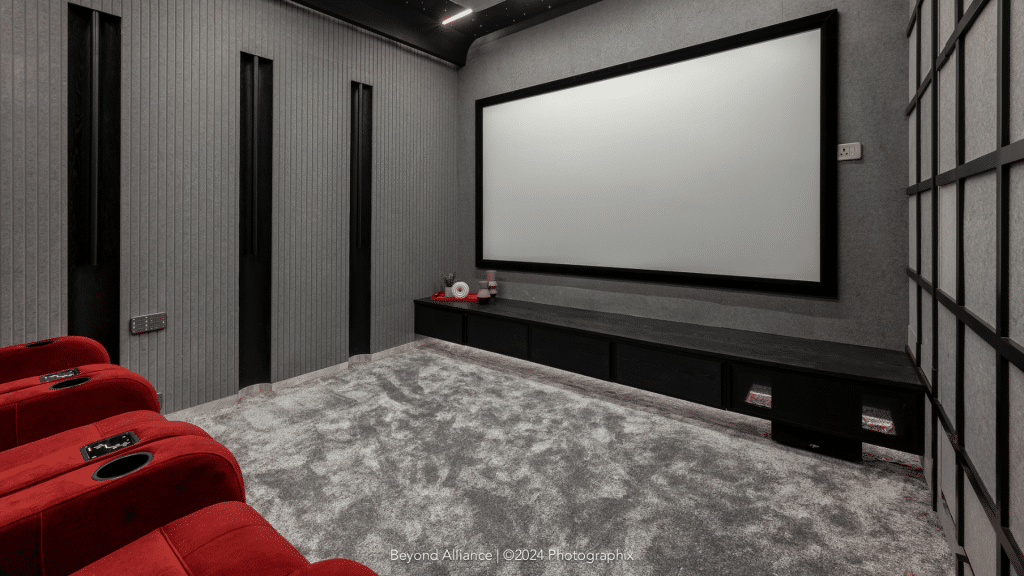
Seamless Integration of these technologies
Technology in this space is designed to keep aesthetics at the epicentre along with acoustics. The form factor of speakers is designed to be concealed in walls without compromising on the drivers of the speakers and the sound signature. No, we don’t need large floor standers in every space to experience good sound. Custom-install speakers do the same trick. Keypads blend into the finish of the wall and enhance the look and feel of the space they occupy. Options are limitless in finishes, veneer or marble, glass or metal, all available in the shade that the designer demands.
The room size in its empty shell is 300 sq. ft., which is reduced to 270 sq. ft. after acoustics are installed. The system includes a Pulse DSP and Anthem AVR for the AVR and processor. Power amplification is handled by Sabre Power Amps, while Krix provides the Front LCR speakers, Surround, and Atmos speakers, as well as the subwoofers. The projector is an LG model, paired with a custom-manufactured screen. Cabling is managed with SCP cables. For seating, OBJE and Draw Four recliners offer comfort and style.
Mihir Kotak, 4th Dimension
Home Theatre Design
The concept-driven theatre room is a part of the Bhoir House spanning 6,500 sq. ft on the terrace floor as an individual entity. Overall the Bhoir House includes a major play of natural materials, concept stones, and exquisite furnishings with bespoke elements that speak out loud.
The theatre room’s concept draws inspiration from nature, incorporating elements of forests and caves. The goal was to recreate the ambience of a cave within the home theatre while preserving a luxurious setting. Lights, comfort and the ambience played a major role in recreating the overall ambiance of the theatre.
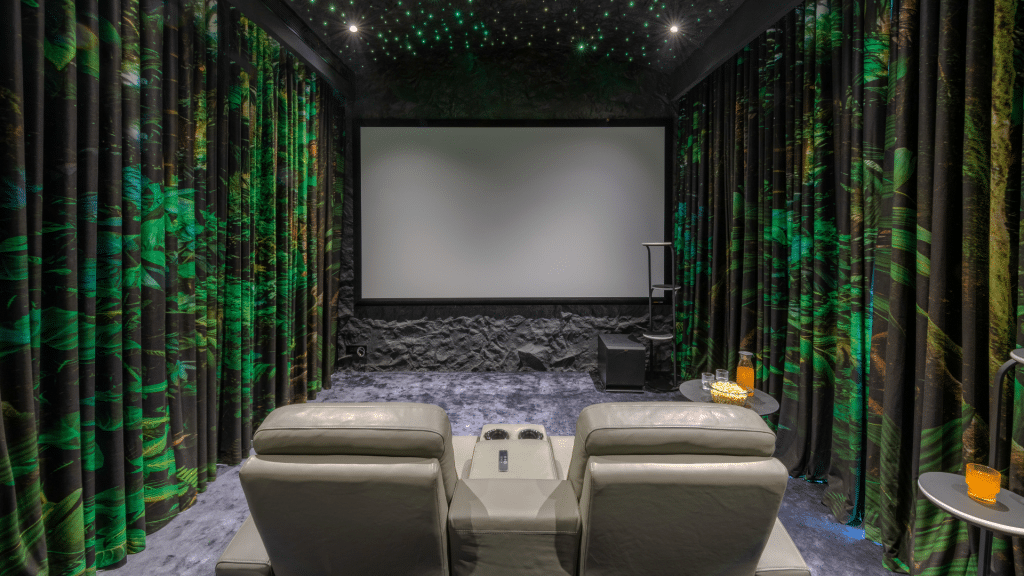
The home theatre room, designed by Kothari Etechnologic Pvt Ltd, covers a total area of 300 sq. ft. and accommodates six seats. The space measures 17’5″ x 17’8″ in its empty shell state and 17’0″ x 17’2″ after acoustics are installed. The audio-visual setup includes a Marantz AVR, Klipsch speakers for Front LCR, Surround, and Atmos channels, and Klipsch subwoofers. The visual components feature a Sony projector and a Screen Research screen. Innovations in the design include the use of FRP material for the ceiling and wall panelling, with glass wool inside for enhanced acoustics. Customised curtains with forest prints add a unique touch to the room. This thoughtful integration of technology and design elements not only delivers exceptional audio-visual performance but also reduces the need for multiple remotes or controls, creating a streamlined and aesthetically pleasing home theatre experience.
Shilpa Jain Balvally, Principal Architect, Studio Osmosis
Adjacent to the dining area in the opulent 6,500 sq. ft. Mumbai residence is a spacious, lavishly designed party cum home theatre room. This versatile space blends flexibility with elegance, offering comfortable seating and a sophisticated mix of colours and mood lighting. Designed as a multifunctional area, it serves both as a home theatre and a party venue. The room’s outdoor-themed ambiance, evocative of a starry night sky, enhances the cinematic experience and can be transformed into a lively party space as needed. The casual, lightweight, and movable seating further adds to its adaptability, allowing the room to seamlessly shift between a relaxed movie-watching environment and a dynamic party hall.
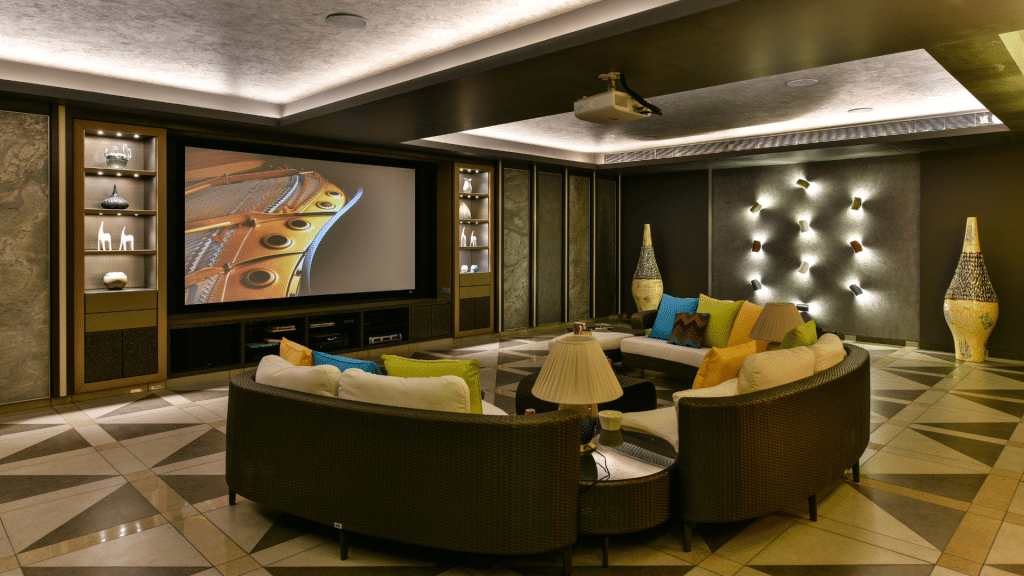
The home theatre, designed and implemented by Ajay Kamath, was initially 300 sq. ft. in its empty shell state, and now measures 270 sq. ft. after acoustics treatment. It features a high-quality array of equipment, including a Yamaha Aventage for the AVR and processor, Behringer power amplifiers, Bose RM105 Front LCR speakers, Origin Acoustics Frameless In-Ceiling speakers for Surround and Atmos channels, and Definitive Technology SuperCube Reference subwoofers. For visual components, the setup includes a Panasonic PT AR100 projector and an Elite 135-inch Acoustic screen. The room is equipped with cutting-edge innovations such as an automated lighting system that enhances the viewing experience by dimming the lights and simulating a starry night sky, creating the perfect mood and ambiance for both films watching and family gatherings.
Future Prospects
Looking towards the future, there are several exciting developments on the horizon. The integration of Virtual Reality (VR) technology into home theatres promises to offer a new dimension of immersion, allowing users to experience content in a fully interactive and three-dimensional environment. Augmented Reality (AR) enhancements have the potential to enrich home theatre experiences by overlaying digital information onto the physical environment, such as providing real-time details about actors or scenes. Innovations in projection technology, including laser projectors and ultra-short throw projectors, are expanding the possibilities for home theatre setups, enabling large-screen experiences in smaller spaces with exceptional image quality.
The home cinema trend is set to expand, driven by advancements in technology and evolving consumer expectations. Whether for a movie night, a family gathering, or a lively party, these dedicated spaces are becoming integral to modern living, providing both luxury and practicality in equal measure. In the next series, we will give you insights into what the brands have to offer for this space.



